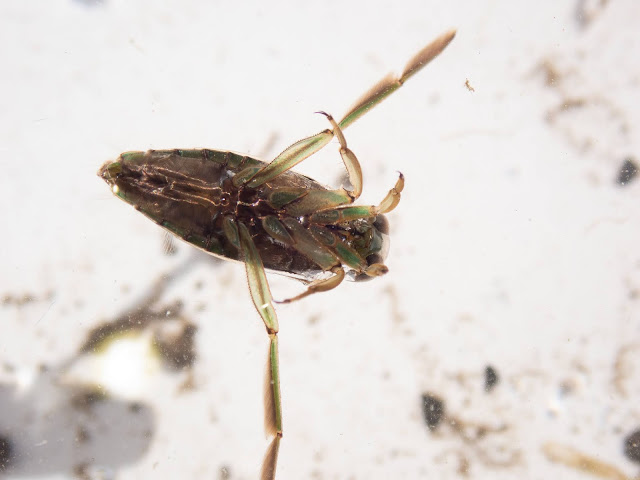Boatman and Backswimmer: Two More TRUE Bugs
 |
| Water Boatman, Homer Lake Wetland, October 16, 2021 |
Checking out the wetland last week (October 16) to see what was still lurking in "the depths" (ok, about a foot deep in the deepest section at that point) I pulled out two more true bugs we've not yet looked at in this blog. They have a lot in common but also some important differences. In common, both water boatmen and backswimmers are true bugs. As noted before, all true bugs (insect order hemiptera), such as the water scorpions and giant water bugs which we've already seen, have piercing mouthparts which they use to suck up their meals. In addition, like most of the aquatic insects and arachnids we've seen, water boatmen and backswimmers carry air bubbles around with them underwater like little scuba tanks. Also in common, both water boatmen and backswimmers have elongated back legs fringed with fine hairs that they use like oars to make their way through the water -- surprisingly fast, actually.
Two important differences between these two insect families: backswimmers, like water scorpions and giant water bugs and actually most other aquatic true bugs, are predators. Those piercing mouthparts are inserted into other insects, tadpoles or anything else they can overpower and digestive enzymes are secreted into the victim and then the contents slurped up via the straw-like mouth. Like water scorpions and giant water bugs, backswimmers are capable of delivering a painful bite. Water boatmen, in contrast, are vegetarians and use their piercing mouthparts on plants for their nourishment. In this regard they resemble cicadas and aphids, which are also true bugs, albeit not aquatic. Water boatmen do not bite humans.
The other big difference is perhaps obvious from the backswimmer's common name. Backswimmers swim on their backs, as in the first photo below, whereas the water boatmen swim "right side up." The backswimmers can turn themselves right side up in the water, as seen in the second photo below. I took the photo of the backswimmer right side up and then as I watched, it took off from my little tray and flew back over to the wetland. It had apparently had enough photoshoot so turned itself wing-side up and took off from the surface of the water!
A final note: in my observations at the wetland this year, backswimmers were much more common than water boatmen. Perhaps the backswimmers are simply more noticeable than the water boatmen, but while I saw or captured multiple backswimmers nearly every time I put a net in the water, October 16 was the first time I recall finding a water boatman. There are over 300 species of water boatmen in the world (about 125 in North America) and over 400 species of backswimmers (but only about 32 species in North America).
 |
| Backswimmer in its normal swimming position -- on its back, Homer Lake Wetland, October 16, 2021 |
 |
| Backswimmer in the water, right-side up, shortly before flying away! |
For more on these aquatic bugs, see
- https://mdc.mo.gov/discover-nature/field-guide/water-boatmen
- https://mdc.mo.gov/discover-nature/field-guide/backswimmers



Beautiful photos and wonderful discussion about the bugs. Thanks, Doug!
ReplyDelete